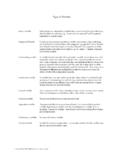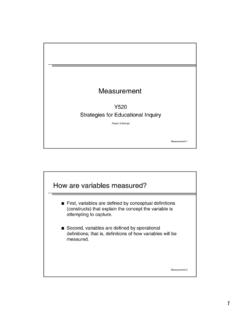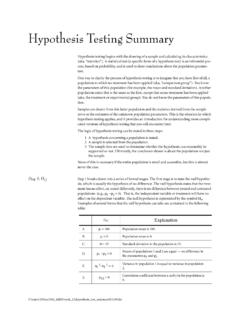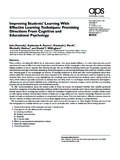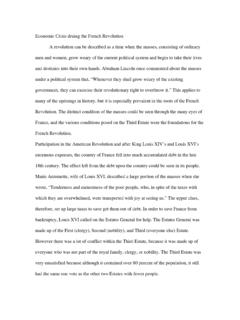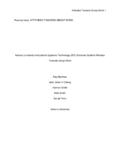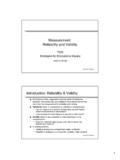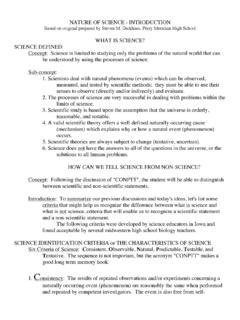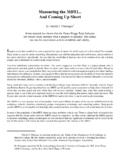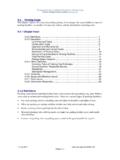Transcription of content analysis 1 - Indiana University Bloomington
1 content analysis By: A. Warm Body, Distinguish Professor Coding the content of documents (like behavior coding) any technique for making inferences by identifying special characteristics of messages (written or oral) artifacts of social communications information is condensed (classified) and made systematically comparable by applying a coding schemeany kind of written document field notes from participant observation, letters, novels, transcriptsof recorded communications (such as shows, interviews, etc. )The steps in content analysis : fully describe the phenomenon to be studies ( portrayal of the elderly in the media) select the media that will be used for data derive coding categories choose categories, status of character, physical attractiveness, context, etc.
2 Count presence or absence of a category place each piece into one of many categories (forced choice) decide on a sampling strategy --you can t count it all train the coders/raters (reliability is important) analyze the data (% s, compare means and variances?)example: Laswell, et al (1949); symbol analysis employed during World War II newspaper content was studied to count the appearance of certain symbols, such as Jews, Stalin, democracy, Russia an affective dimension was added--indulgent, supportive, neutral, etc. sometimes further divided into those stressing strength, goodness, morality, weakness, immorality, etc.
3 Nowdays this can be done with a computer sampling strategy newspapers only sampled every 10th one from an alphabetical list control geographical location, political and economic orientation, ethnic groupIn general, we have to decide--whatgets counted (words, pictures?) what levelsofanalysis(categories, amounts?),what coding frames(every 10th page, every other sentence?)Types of COMMUNICATION COMPONENTS: message, sender, audiencemessage components explicit themes, emphasis on various topics, amount of space or time devoted to topics, numbers on prose: counting vs.
4 Rating counting--little judgment, less discovery rating--much judgment, more discovery usually have a combinationcountangry words in text or rateanger in sentences or paragraphs count angry words, what isan angry word??? end up using some judgment unless it s totally spelled out and the more it s spelled out, the more you lose Anger countthese words: fed up IIII II irritated III disgusted II etc. IIII III or ratethese sentences: I find the idea to be warm very angry0 1 2 3 4 5examples of elements to count.
5 Items, words sentences paragraphs, characters, semantics concepts, themes, Items represents the whole unit of the sender's message may be an entire book, a letter, speech, diary, newspaper, or even an in-depth smallest element least judgment generally results in frequency distributionsSentences definitely more judgment than words but less than paragraphs, etc. Paragraphs difficulties result in attempting to code and classify poor consistency among writer on how to write a paragraphSemantics meanings of overall sentence, paragraph, etc.
6 Requires a lot of judgmentCharacters (persons) count the number of times a specific person is mentionedConcepts involve words grouped together into conceptual clusters (ideas) a conceptual cluster may form around the idea of deviance. Words such as crime, delinquency, money laundering, and fraud might cluster around the conceptual idea of deviance leads toward more latent than manifest content , more rating, judgment, etc. although word clusters could be simply countedThemes broader than a concept (almost like a mood) can be made up of many concepts must further specify the unit --theme of each sentence, each paragraph, the whole book?
7 ???Combinations of Elements Berg's (1983) subjective definitions for Jewish affiliationalcategories used combination of word, sentence, and paragraph elements lifteddefinition components from interview transcripts cutting across elements to formulateinterviewee s definition each definition annotated with the transcript number example--Interview #60: ORTHODOX Well, I guess, Orthodox keep kosher in [the] home and away from home. Observe the Sabbath, and, you , actually if somebody did [those] and considered themselves an Orthodox Jew, to me that would be enough.
8 I would say that they were Orthodox. CONSERVATIVE Conservative, I guess, is the fellow who doesn't want to say he's Reform, because it's objectionable to him. But he's a long way from being Orthodox. REFORM Reform is just somebody that, say they are Jewish because they don't want to lose their identity. But actually want to be considered a Reform, 'cause I say I'm Jewish, but I wouldn't want to be associated as a Jew if I didn't actually observe any of the laws. NONPRACTICING Well, a Nonpracticing is the guy who would have no temple affiliation, no affiliation with being Jewish at all, except that he considers himself a Jew.
9 I guess he practices in no way, except to major approaches to categorizing in a coding system: common classes, special classes, and theoretical classes1. Common classes. used by virtually anyone in society (for example, age, gender, mother, father, teacher, boss, lover, etc.) essential in assessing whether certain demographic characteristics are related to patterns that arise from other coding2. Special Classes. colloquial categories includes jargon of various professions, petty larceny vs. that other category3. Theoretical Classes.
10 Those that emergein the course of analyzing the data category labels generally borrowed from special classes ( psychojargon) their substance is grounded in the data not immediately knowable until observers spend considerable time with the content "in vivo codes" vs."sociological constructs" in vivo codes are literal actual words sociological constructs are formulatedby the analyst "professional attitude," "family oriented," "obsessive workaholic," "educationally minded," might represent examples of sociological constructs may add breadth and depthIn General.

